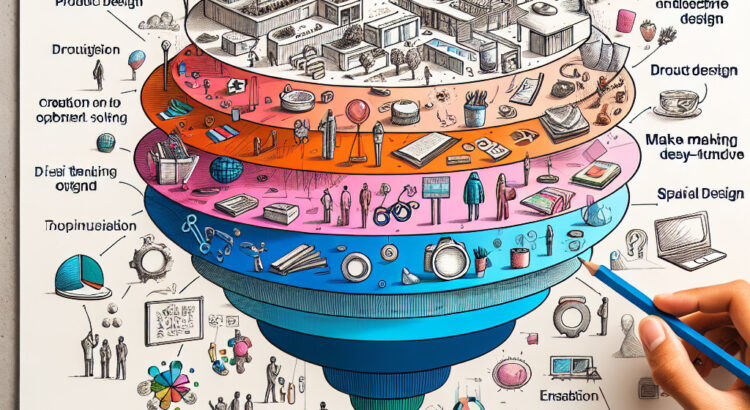- How design influences consumer behavior
- Design as a tool for problem-solving
- Design as a form of communication
- The connection between design and sustainability
- Design as a reflection of societal values and norms
- The role of design in healthcare and wellness
- The role of design in creating memorable brand experiences
- The connection between design and storytelling in marketing and branding
How design influences consumer behavior
Visual appeal
One of the most obvious ways in which design influences consumer behavior is through visual appeal. Studies have shown that consumers are more likely to purchase products that are visually appealing, even if they are more expensive than less attractive alternatives. This is why companies invest heavily in packaging design, website layout, and other visual elements that can attract and retain customers.
Emotional connection
Design can also create an emotional connection with consumers, which can influence their purchasing decisions. For example, a brand that uses warm colors and friendly fonts in its marketing materials may evoke feelings of trust and familiarity in consumers, making them more likely to choose that brand over competitors. By tapping into consumers’ emotions, businesses can create a strong bond with their target audience and increase brand loyalty.
Usability
Another important aspect of design that influences consumer behavior is usability. A well-designed product or website is easy to navigate and use, which can make the shopping experience more enjoyable for consumers. On the other hand, a poorly designed product or website can frustrate consumers and drive them away from a brand. By focusing on usability, businesses can improve the overall customer experience and increase sales.
Brand perception
Design also plays a key role in shaping consumers’ perceptions of a brand. A brand that uses sleek, modern design elements may be perceived as innovative and cutting-edge, while a brand that uses traditional design elements may be seen as reliable and trustworthy. By carefully crafting their design elements, businesses can shape how consumers view their brand and differentiate themselves from competitors.
Call to action
Finally, design can influence consumer behavior by prompting action. A well-designed call to action button on a website, for example, can encourage consumers to make a purchase or sign up for a newsletter. By using design elements strategically, businesses can guide consumers towards desired actions and ultimately drive conversions.
Conclusion
Design is a powerful tool that can influence consumer behavior in a variety of ways. By focusing on visual appeal, emotional connection, usability, brand perception, and call to action, businesses can leverage design to attract and retain customers, drive sales, and build brand loyalty. Understanding how design influences consumer behavior is essential for businesses looking to succeed in today’s competitive marketplace.
- visual appeal
- emotional connection
- usability
- brand perception
- call to action
- design elements
- consumer behavior
- brand loyalty
- customer experience
- competitive marketplace
#design #consumerbehavior #brandloyalty #visualappeal #emotionalconnection #usability
Design as a tool for problem-solving
Design thinking, a methodology that emphasizes empathy, ideation, prototyping, and testing, is a popular approach used by designers to tackle complex challenges. By putting the needs and experiences of users at the center of the design process, designers can create solutions that are not only functional but also meaningful and impactful.
Designers also use a variety of tools and techniques to visualize and communicate their ideas. From sketches and wireframes to prototypes and mockups, design artifacts help to bring concepts to life and facilitate collaboration and feedback. By iterating and refining their designs based on user feedback, designers can create solutions that are user-centered and effective.
In addition to problem-solving, design can also be a powerful tool for communication and persuasion. Visual elements such as color, typography, and layout can influence how we perceive and interpret information. By using design principles effectively, designers can create compelling and engaging experiences that resonate with their audience.
Overall, design is a versatile and valuable tool for addressing a wide range of challenges. By approaching problems with a design mindset, we can unlock new possibilities and create solutions that are not only functional but also beautiful and meaningful.
| Hashtagi | Słowa kluczowe | Frazy kluczowe |
|---|---|---|
| #designthinking | design, problem-solving, innovation | user-centered design solutions |
| #visualcommunication | communication, persuasion, visual elements | design principles for effective communication |
| #userexperience | empathy, prototyping, testing | improving user experiences through design |
design, problem-solving, innovation, user-centered design solutions, communication, persuasion, visual elements, design principles for effective communication, empathy, prototyping, testing, improving user experiences through design.
Design as a form of communication
Visual language
Design is a form of visual language that speaks to us on a subconscious level. It uses colors, shapes, typography, and imagery to convey meaning and evoke emotions. Just like spoken or written language, design has its own grammar and syntax that designers use to create effective communication.
Emotional impact
Design has the power to evoke emotions and create connections with the audience. A well-designed piece can make us feel happy, sad, excited, or even nostalgic. It can trigger memories, spark curiosity, or inspire action. Designers use color psychology, typography, and composition to create the desired emotional response.
Functionality
Design is not just about aesthetics; it is also about functionality. Good design should be user-friendly, intuitive, and easy to understand. Whether it’s a website navigation, a product packaging, or a wayfinding system, design should make our lives easier and more enjoyable.
Brand identity
Design plays a crucial role in shaping a brand’s identity and personality. A logo, a color scheme, or a typeface can instantly communicate the values and characteristics of a brand. Design helps differentiate one brand from another and creates a memorable impression in the minds of consumers.
Accessibility
Design should be inclusive and accessible to everyone. It should consider the needs of people with disabilities, different cultural backgrounds, and varying levels of literacy. Designers should strive to create designs that are easy to understand and use by a diverse audience.
Conclusion
Design is a powerful form of communication that influences how we perceive and interact with the world. It conveys messages, emotions, and ideas through visual language, evokes emotions, and creates connections with the audience. Good design is not just about aesthetics; it is also about functionality, brand identity, and accessibility.
#design #communication #visuallanguage #emotionalimpact #functionality #brandidentity #accessibility
frazy kluczowe:
– the importance of design in communication
– how design shapes our perception
– the role of design in branding
– inclusive design for all users
– the power of visual language in design
The connection between design and sustainability
Key principles of sustainable design:
- Use of renewable materials
- Energy efficiency
- Waste reduction
- Recycling and reuse
- Biophilic design
By incorporating these principles into their work, designers can create products and spaces that are not only aesthetically pleasing but also environmentally friendly and socially responsible.
The benefits of sustainable design:
- Reduced environmental impact
- Cost savings
- Improved health and well-being
- Enhanced brand reputation
- Long-term sustainability
Designers have a unique opportunity to drive positive change through their work, by creating solutions that are both beautiful and sustainable. By embracing sustainable design principles, we can create a more harmonious relationship between humans and the natural world.
Conclusion:
The connection between design and sustainability is a powerful force for positive change in our world. By incorporating sustainable principles into their work, designers can help create a more sustainable future for all.
#design #sustainability #environment #renewablematerials #energyefficiency #wastereduction #recycling #biophilicdesign #environmentalimpact #costsavings #health #wellbeing #brandreputation #sustainablefuture
frazy kluczowe:
– Connection between design and sustainability
– Role of design in promoting sustainability
– Key principles of sustainable design
– Benefits of sustainable design
– Positive change through sustainable design
– Harmonious relationship between humans and the natural world.
Design as a reflection of societal values and norms
Architecture is another area where design reflects societal values. The buildings we construct and the spaces we inhabit are a physical manifestation of our collective priorities and aspirations. For example, the rise of sustainable architecture in recent years reflects a growing awareness of environmental issues and a desire to live more harmoniously with nature.
Technology is also a key player in shaping design and reflecting societal values. The devices we use, from smartphones to smart home appliances, are designed to meet our needs and desires as consumers. The sleek, minimalist aesthetic of many tech products reflects a cultural preference for simplicity and efficiency.
Ultimately, design is a powerful tool for expressing and shaping societal values. By understanding the ways in which design reflects our culture, we can gain insight into our collective beliefs and aspirations. As designers, it is important to be mindful of the impact our work has on society and to use our skills to create a more inclusive and sustainable world.
Key takeaways:
- Design is a reflection of societal values and norms.
- Fashion, architecture, and technology all play a role in shaping design.
- Designers have a responsibility to create inclusive and sustainable solutions.
Hashtags:
#design #society #values #norms #fashion #architecture #technology
Keywords:
design, society, values, norms, fashion, architecture, technology
Long-tail phrases:
design as a reflection of societal values, societal norms in design, impact of design on society
The role of design in healthcare and wellness
Hospital Design
One of the most obvious ways in which design affects healthcare is through the layout and design of hospitals. A well-designed hospital can improve patient flow, reduce the risk of infections, and create a more welcoming environment for patients and their families. For example, hospitals that incorporate natural light, soothing colors, and comfortable furniture can help reduce stress and anxiety in patients.
Medical Device Design
Design also plays a critical role in the development of medical devices. User-friendly design can make it easier for healthcare professionals to use medical equipment effectively, leading to better patient care. Additionally, well-designed medical devices can improve patient compliance and make it easier for individuals to manage their own health conditions.
Wellness Design
Design is not just important in healthcare settings – it also plays a role in promoting wellness and healthy living. From the design of fitness trackers to the layout of wellness centers, design can influence behavior and encourage individuals to make healthier choices. For example, a well-designed gym with modern equipment and motivating decor can inspire people to exercise regularly.
Conclusion
Overall, design plays a crucial role in healthcare and wellness, impacting everything from hospital layouts to medical device design. By prioritizing good design principles, healthcare organizations can improve patient outcomes, enhance the patient experience, and promote overall well-being.
#healthcare #wellness #design #hospital #medicaldevice #wellnessdesign #patientexperience #healthyliving
słowa kluczowe: healthcare, wellness, design, hospital, medical device, wellness design, patient experience, healthy living
frazy kluczowe: role of design in healthcare, impact of design on wellness, importance of good design in hospitals, user-friendly medical device design, promoting wellness through design, benefits of well-designed healthcare facilities.
The role of design in creating memorable brand experiences
Another important aspect of design in creating memorable brand experiences is storytelling. Design can be used to tell a brand’s story, communicate its values and mission, and create an emotional connection with customers. By using visual elements such as images, graphics, and videos, brands can evoke certain emotions and create a memorable experience for customers.
Design also plays a role in creating a seamless and intuitive user experience. A well-designed website or app can make it easy for customers to navigate, find information, and make purchases, leading to a positive experience and increased brand loyalty. Design thinking, which focuses on understanding the needs and preferences of users, can help brands create products and services that meet the needs of their customers.
In conclusion, design is a powerful tool for creating memorable brand experiences. By focusing on consistency, storytelling, and user experience, brands can differentiate themselves from the competition, build trust and loyalty among customers, and create lasting impressions that drive business success.
| Design Element | Role |
|---|---|
| Logo | Reinforces brand identity |
| Color Scheme | Communicates brand personality |
| Typography | Enhances readability and brand recognition |
| Imagery | Elicits emotions and creates a connection with customers |
#design #branding #userexperience #storytelling #consistency
Keywords: design, brand experiences, consistency, storytelling, user experience
Long-tail phrases: the importance of design in brand experiences, how design influences customer perception, creating emotional connections through design.
The connection between design and storytelling in marketing and branding
Design plays a crucial role in branding and marketing. It is the visual representation of a brand and can help communicate the brand’s values, personality, and message. Good design can attract attention, create a positive first impression, and differentiate a brand from its competitors. From logos and packaging to websites and advertisements, design is everywhere in marketing and branding.
Storytelling, on the other hand, is the art of using narratives to communicate a brand’s message and engage with customers on an emotional level. Stories have the power to evoke emotions, create empathy, and build trust with the audience. By telling compelling stories, businesses can humanize their brand, connect with customers on a deeper level, and leave a lasting impression.
When design and storytelling are combined in marketing and branding, they can create a powerful synergy that resonates with customers and drives brand loyalty. A well-designed brand story can capture the audience’s attention, evoke emotions, and inspire action. By integrating design elements such as colors, typography, and imagery with storytelling techniques like character development, conflict resolution, and emotional arcs, businesses can create a cohesive brand experience that leaves a lasting impact.
One example of a brand that successfully uses design and storytelling in marketing and branding is Apple. The company’s sleek and minimalist design aesthetic reflects its commitment to simplicity, innovation, and quality. Apple’s brand story, on the other hand, revolves around creativity, empowerment, and individuality. By combining these elements, Apple has created a strong emotional connection with its customers, who see the brand as a symbol of innovation and creativity.
In conclusion, is essential for businesses looking to create a strong emotional connection with their customers and build brand loyalty. By integrating design elements with storytelling techniques, businesses can create a cohesive brand experience that resonates with their target audience and drives sales.
- Design and storytelling are essential elements in marketing and branding
- Good design can attract attention and differentiate a brand
- Storytelling can create empathy and build trust with customers
- Combining design and storytelling can create a powerful brand experience
#design #storytelling #marketing #branding #emotionalconnection #brandloyalty
Keywords: design, storytelling, marketing, branding, emotional connection, brand loyalty
Long-tail phrases: The importance of design and storytelling in marketing, How design and storytelling can drive brand loyalty, The power of combining design and storytelling in branding.



